E-commerce Strategies within the UK: A Nestle Case Study Report
VerifiedAdded on 2021/01/02
|20
|5821
|409
Report
AI Summary
This report presents a comprehensive analysis of e-commerce strategies, specifically focusing on a case study of Nestle UK. It begins with an introduction to e-commerce, its definition, and its significance in the context of Nestle's business operations. The report delves into Nestle's e-commerce strategies, including personalization, content creation, and channel integration. It examines customer satisfaction and emerging trends in the e-commerce industry. Furthermore, it explores the role of digital technologies and Porter's five forces in shaping Nestle's competitive landscape. The research methodology, including the research philosophy and approach, is outlined. The report also addresses key research questions regarding the impact of e-commerce on retail organizations, competitive positioning, consumer behavior, and security concerns. The literature review covers various aspects of e-commerce, including e-commerce strategy, customer satisfaction, digital technology, and Porter’s five forces. The report concludes with recommendations, limitations, and an overview of e-commerce's impact on Nestle's performance and future trends within the UK.
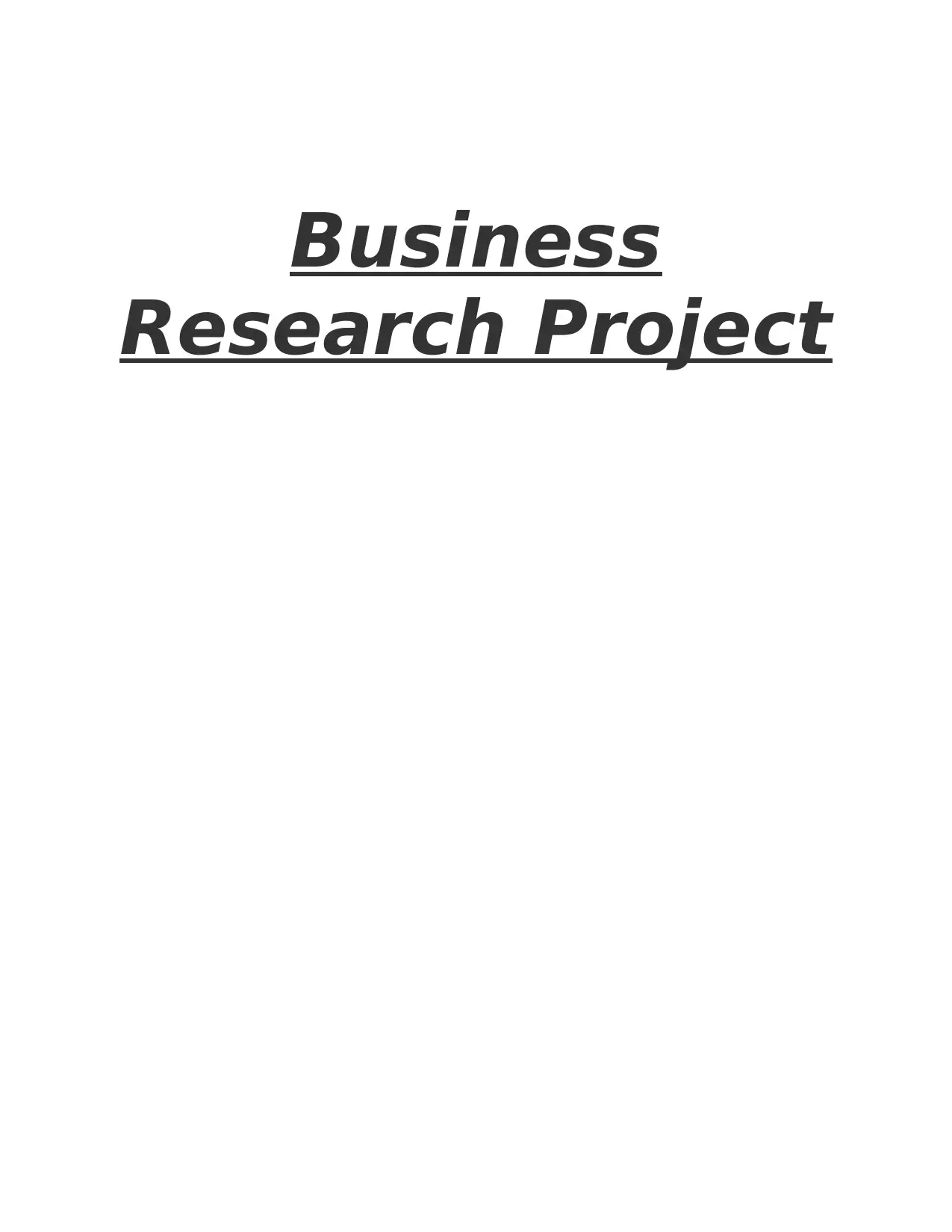
Business
Research Project
Research Project
Paraphrase This Document
Need a fresh take? Get an instant paraphrase of this document with our AI Paraphraser
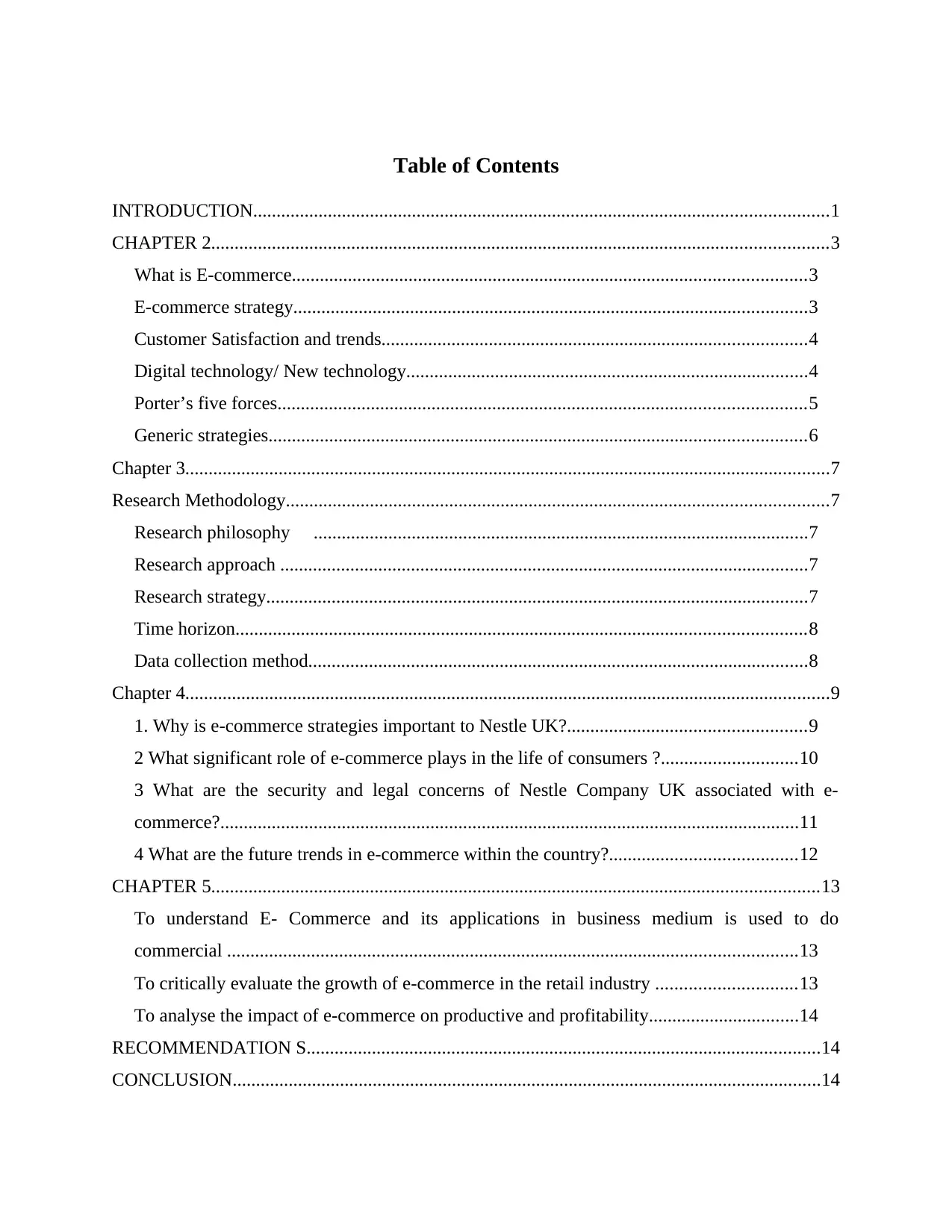
Table of Contents
INTRODUCTION...........................................................................................................................1
CHAPTER 2....................................................................................................................................3
What is E-commerce..............................................................................................................3
E-commerce strategy..............................................................................................................3
Customer Satisfaction and trends...........................................................................................4
Digital technology/ New technology......................................................................................4
Porter’s five forces.................................................................................................................5
Generic strategies...................................................................................................................6
Chapter 3..........................................................................................................................................7
Research Methodology....................................................................................................................7
Research philosophy ..........................................................................................................7
Research approach .................................................................................................................7
Research strategy....................................................................................................................7
Time horizon..........................................................................................................................8
Data collection method...........................................................................................................8
Chapter 4..........................................................................................................................................9
1. Why is e-commerce strategies important to Nestle UK?...................................................9
2 What significant role of e-commerce plays in the life of consumers ?.............................10
3 What are the security and legal concerns of Nestle Company UK associated with e-
commerce?............................................................................................................................11
4 What are the future trends in e-commerce within the country?........................................12
CHAPTER 5..................................................................................................................................13
To understand E- Commerce and its applications in business medium is used to do
commercial ..........................................................................................................................13
To critically evaluate the growth of e-commerce in the retail industry ..............................13
To analyse the impact of e-commerce on productive and profitability................................14
RECOMMENDATION S..............................................................................................................14
CONCLUSION..............................................................................................................................14
INTRODUCTION...........................................................................................................................1
CHAPTER 2....................................................................................................................................3
What is E-commerce..............................................................................................................3
E-commerce strategy..............................................................................................................3
Customer Satisfaction and trends...........................................................................................4
Digital technology/ New technology......................................................................................4
Porter’s five forces.................................................................................................................5
Generic strategies...................................................................................................................6
Chapter 3..........................................................................................................................................7
Research Methodology....................................................................................................................7
Research philosophy ..........................................................................................................7
Research approach .................................................................................................................7
Research strategy....................................................................................................................7
Time horizon..........................................................................................................................8
Data collection method...........................................................................................................8
Chapter 4..........................................................................................................................................9
1. Why is e-commerce strategies important to Nestle UK?...................................................9
2 What significant role of e-commerce plays in the life of consumers ?.............................10
3 What are the security and legal concerns of Nestle Company UK associated with e-
commerce?............................................................................................................................11
4 What are the future trends in e-commerce within the country?........................................12
CHAPTER 5..................................................................................................................................13
To understand E- Commerce and its applications in business medium is used to do
commercial ..........................................................................................................................13
To critically evaluate the growth of e-commerce in the retail industry ..............................13
To analyse the impact of e-commerce on productive and profitability................................14
RECOMMENDATION S..............................................................................................................14
CONCLUSION..............................................................................................................................14

LIMITATIONS OF STUDY.........................................................................................................15
⊘ This is a preview!⊘
Do you want full access?
Subscribe today to unlock all pages.

Trusted by 1+ million students worldwide
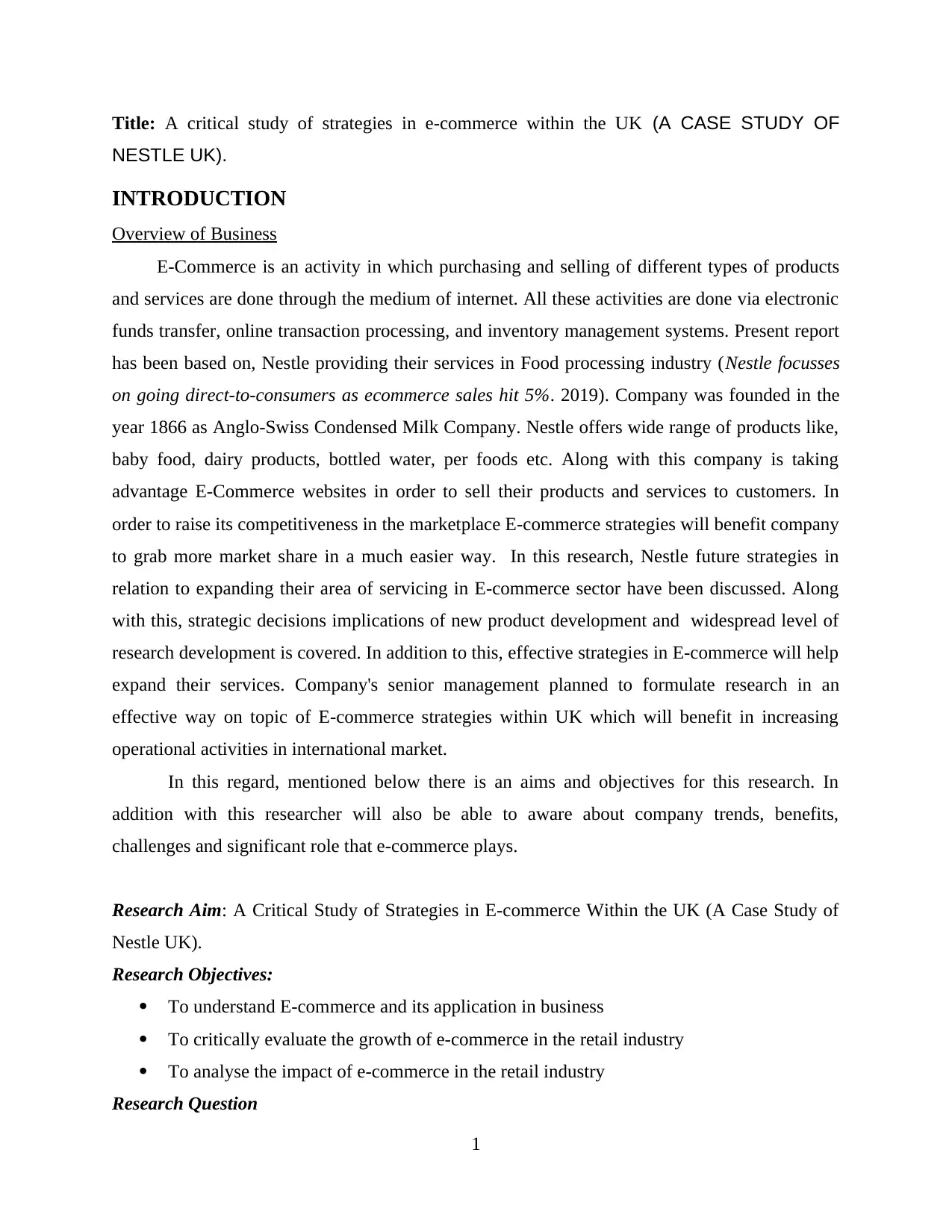
Title: A critical study of strategies in e-commerce within the UK (A CASE STUDY OF
NESTLE UK).
INTRODUCTION
Overview of Business
E-Commerce is an activity in which purchasing and selling of different types of products
and services are done through the medium of internet. All these activities are done via electronic
funds transfer, online transaction processing, and inventory management systems. Present report
has been based on, Nestle providing their services in Food processing industry (Nestle focusses
on going direct-to-consumers as ecommerce sales hit 5%. 2019). Company was founded in the
year 1866 as Anglo-Swiss Condensed Milk Company. Nestle offers wide range of products like,
baby food, dairy products, bottled water, per foods etc. Along with this company is taking
advantage E-Commerce websites in order to sell their products and services to customers. In
order to raise its competitiveness in the marketplace E-commerce strategies will benefit company
to grab more market share in a much easier way. In this research, Nestle future strategies in
relation to expanding their area of servicing in E-commerce sector have been discussed. Along
with this, strategic decisions implications of new product development and widespread level of
research development is covered. In addition to this, effective strategies in E-commerce will help
expand their services. Company's senior management planned to formulate research in an
effective way on topic of E-commerce strategies within UK which will benefit in increasing
operational activities in international market.
In this regard, mentioned below there is an aims and objectives for this research. In
addition with this researcher will also be able to aware about company trends, benefits,
challenges and significant role that e-commerce plays.
Research Aim: A Critical Study of Strategies in E-commerce Within the UK (A Case Study of
Nestle UK).
Research Objectives:
To understand E-commerce and its application in business
To critically evaluate the growth of e-commerce in the retail industry
To analyse the impact of e-commerce in the retail industry
Research Question
1
NESTLE UK).
INTRODUCTION
Overview of Business
E-Commerce is an activity in which purchasing and selling of different types of products
and services are done through the medium of internet. All these activities are done via electronic
funds transfer, online transaction processing, and inventory management systems. Present report
has been based on, Nestle providing their services in Food processing industry (Nestle focusses
on going direct-to-consumers as ecommerce sales hit 5%. 2019). Company was founded in the
year 1866 as Anglo-Swiss Condensed Milk Company. Nestle offers wide range of products like,
baby food, dairy products, bottled water, per foods etc. Along with this company is taking
advantage E-Commerce websites in order to sell their products and services to customers. In
order to raise its competitiveness in the marketplace E-commerce strategies will benefit company
to grab more market share in a much easier way. In this research, Nestle future strategies in
relation to expanding their area of servicing in E-commerce sector have been discussed. Along
with this, strategic decisions implications of new product development and widespread level of
research development is covered. In addition to this, effective strategies in E-commerce will help
expand their services. Company's senior management planned to formulate research in an
effective way on topic of E-commerce strategies within UK which will benefit in increasing
operational activities in international market.
In this regard, mentioned below there is an aims and objectives for this research. In
addition with this researcher will also be able to aware about company trends, benefits,
challenges and significant role that e-commerce plays.
Research Aim: A Critical Study of Strategies in E-commerce Within the UK (A Case Study of
Nestle UK).
Research Objectives:
To understand E-commerce and its application in business
To critically evaluate the growth of e-commerce in the retail industry
To analyse the impact of e-commerce in the retail industry
Research Question
1
Paraphrase This Document
Need a fresh take? Get an instant paraphrase of this document with our AI Paraphraser

Does e-commerce have an impact on retail organisations?
Does e-commerce improve E-Commerce competitive positioning of organisations?
What significant role of e-commerce plays in the life of consumers?
What are the security and legal concerns of Nestle Company UK associated with e-
commerce?
What are the future trends in e-commerce within the country?
CHAPTER 2
LITERATURE REVIEW
2
Does e-commerce improve E-Commerce competitive positioning of organisations?
What significant role of e-commerce plays in the life of consumers?
What are the security and legal concerns of Nestle Company UK associated with e-
commerce?
What are the future trends in e-commerce within the country?
CHAPTER 2
LITERATURE REVIEW
2
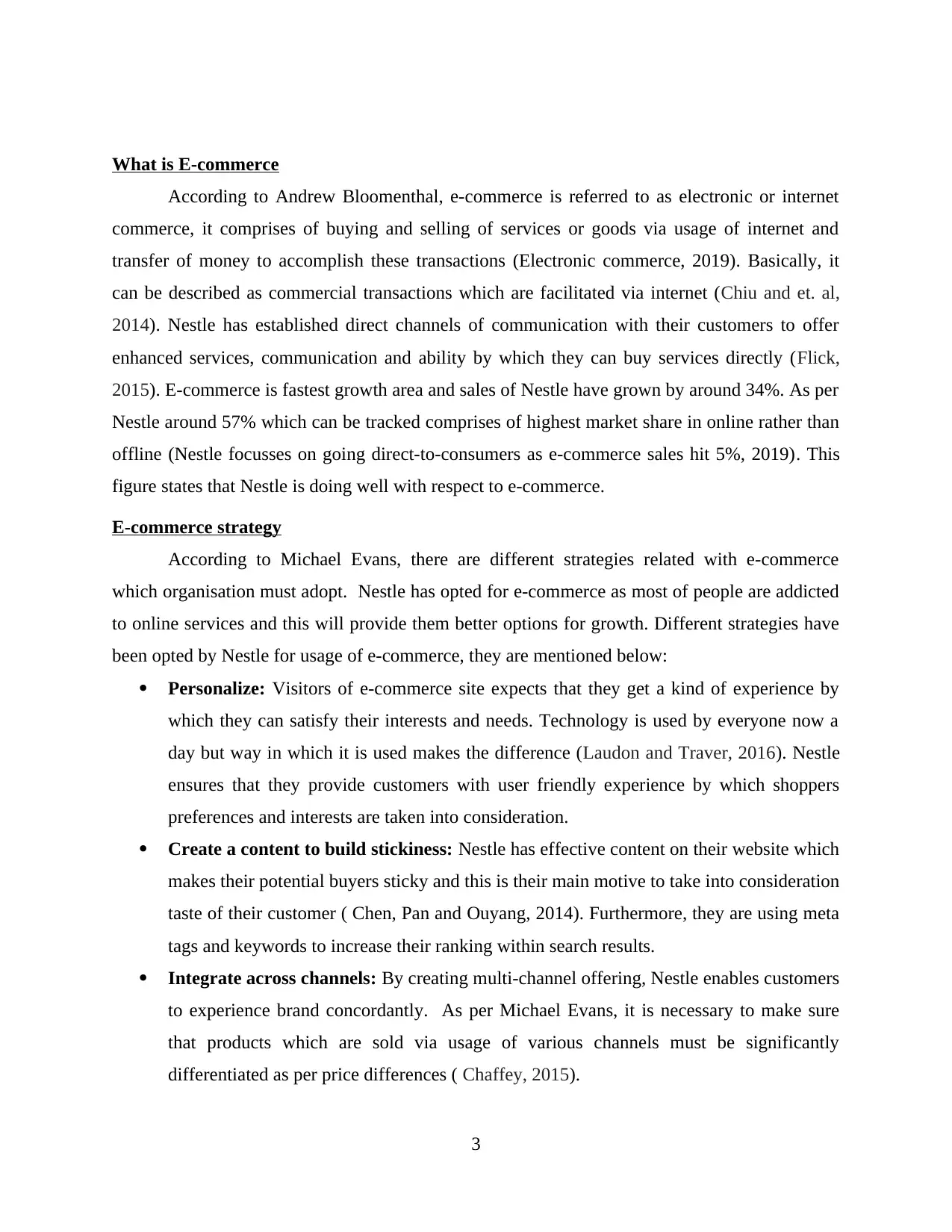
What is E-commerce
According to Andrew Bloomenthal, e-commerce is referred to as electronic or internet
commerce, it comprises of buying and selling of services or goods via usage of internet and
transfer of money to accomplish these transactions (Electronic commerce, 2019). Basically, it
can be described as commercial transactions which are facilitated via internet (Chiu and et. al,
2014). Nestle has established direct channels of communication with their customers to offer
enhanced services, communication and ability by which they can buy services directly (Flick,
2015). E-commerce is fastest growth area and sales of Nestle have grown by around 34%. As per
Nestle around 57% which can be tracked comprises of highest market share in online rather than
offline (Nestle focusses on going direct-to-consumers as e-commerce sales hit 5%, 2019). This
figure states that Nestle is doing well with respect to e-commerce.
E-commerce strategy
According to Michael Evans, there are different strategies related with e-commerce
which organisation must adopt. Nestle has opted for e-commerce as most of people are addicted
to online services and this will provide them better options for growth. Different strategies have
been opted by Nestle for usage of e-commerce, they are mentioned below:
Personalize: Visitors of e-commerce site expects that they get a kind of experience by
which they can satisfy their interests and needs. Technology is used by everyone now a
day but way in which it is used makes the difference (Laudon and Traver, 2016). Nestle
ensures that they provide customers with user friendly experience by which shoppers
preferences and interests are taken into consideration.
Create a content to build stickiness: Nestle has effective content on their website which
makes their potential buyers sticky and this is their main motive to take into consideration
taste of their customer ( Chen, Pan and Ouyang, 2014). Furthermore, they are using meta
tags and keywords to increase their ranking within search results.
Integrate across channels: By creating multi-channel offering, Nestle enables customers
to experience brand concordantly. As per Michael Evans, it is necessary to make sure
that products which are sold via usage of various channels must be significantly
differentiated as per price differences ( Chaffey, 2015).
3
According to Andrew Bloomenthal, e-commerce is referred to as electronic or internet
commerce, it comprises of buying and selling of services or goods via usage of internet and
transfer of money to accomplish these transactions (Electronic commerce, 2019). Basically, it
can be described as commercial transactions which are facilitated via internet (Chiu and et. al,
2014). Nestle has established direct channels of communication with their customers to offer
enhanced services, communication and ability by which they can buy services directly (Flick,
2015). E-commerce is fastest growth area and sales of Nestle have grown by around 34%. As per
Nestle around 57% which can be tracked comprises of highest market share in online rather than
offline (Nestle focusses on going direct-to-consumers as e-commerce sales hit 5%, 2019). This
figure states that Nestle is doing well with respect to e-commerce.
E-commerce strategy
According to Michael Evans, there are different strategies related with e-commerce
which organisation must adopt. Nestle has opted for e-commerce as most of people are addicted
to online services and this will provide them better options for growth. Different strategies have
been opted by Nestle for usage of e-commerce, they are mentioned below:
Personalize: Visitors of e-commerce site expects that they get a kind of experience by
which they can satisfy their interests and needs. Technology is used by everyone now a
day but way in which it is used makes the difference (Laudon and Traver, 2016). Nestle
ensures that they provide customers with user friendly experience by which shoppers
preferences and interests are taken into consideration.
Create a content to build stickiness: Nestle has effective content on their website which
makes their potential buyers sticky and this is their main motive to take into consideration
taste of their customer ( Chen, Pan and Ouyang, 2014). Furthermore, they are using meta
tags and keywords to increase their ranking within search results.
Integrate across channels: By creating multi-channel offering, Nestle enables customers
to experience brand concordantly. As per Michael Evans, it is necessary to make sure
that products which are sold via usage of various channels must be significantly
differentiated as per price differences ( Chaffey, 2015).
3
⊘ This is a preview!⊘
Do you want full access?
Subscribe today to unlock all pages.

Trusted by 1+ million students worldwide
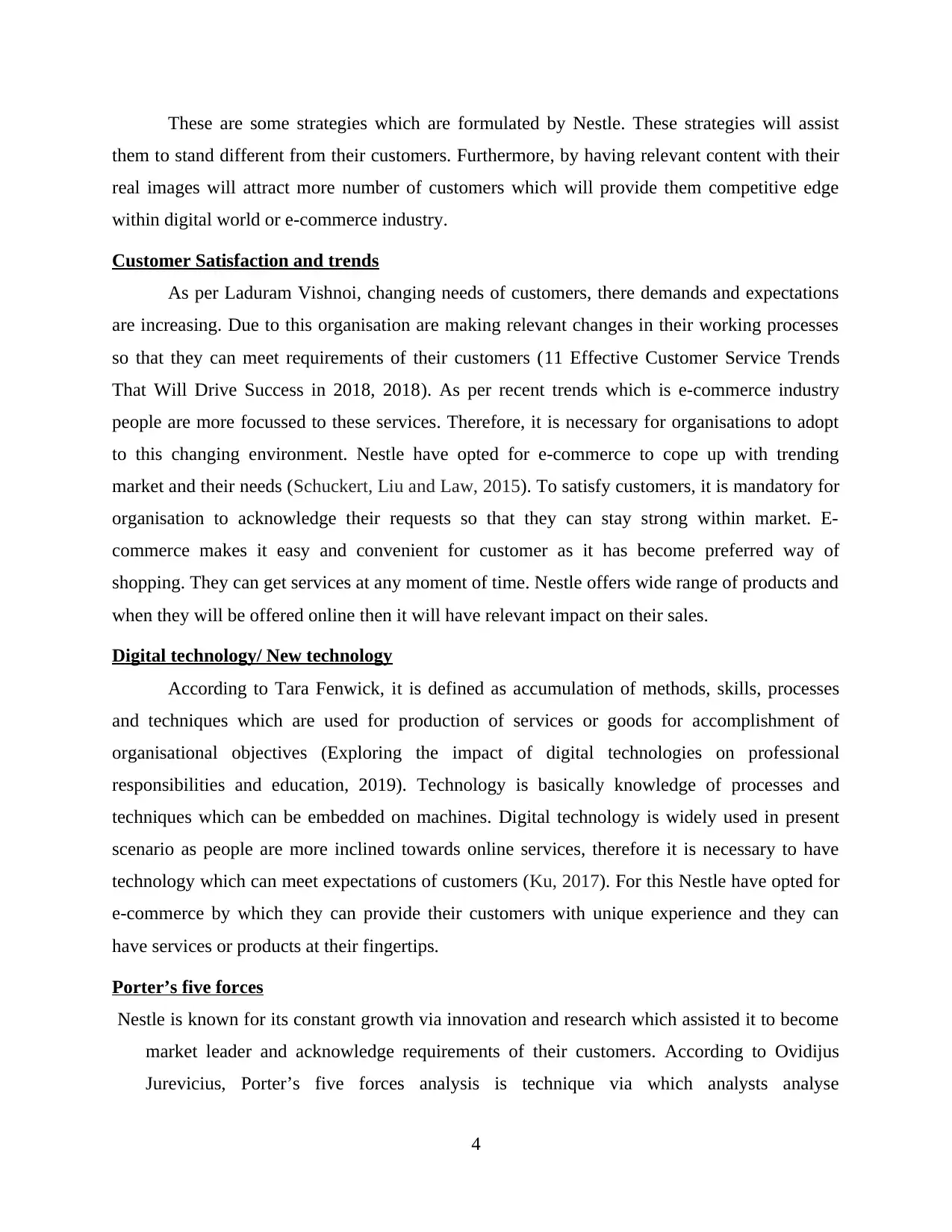
These are some strategies which are formulated by Nestle. These strategies will assist
them to stand different from their customers. Furthermore, by having relevant content with their
real images will attract more number of customers which will provide them competitive edge
within digital world or e-commerce industry.
Customer Satisfaction and trends
As per Laduram Vishnoi, changing needs of customers, there demands and expectations
are increasing. Due to this organisation are making relevant changes in their working processes
so that they can meet requirements of their customers (11 Effective Customer Service Trends
That Will Drive Success in 2018, 2018). As per recent trends which is e-commerce industry
people are more focussed to these services. Therefore, it is necessary for organisations to adopt
to this changing environment. Nestle have opted for e-commerce to cope up with trending
market and their needs (Schuckert, Liu and Law, 2015). To satisfy customers, it is mandatory for
organisation to acknowledge their requests so that they can stay strong within market. E-
commerce makes it easy and convenient for customer as it has become preferred way of
shopping. They can get services at any moment of time. Nestle offers wide range of products and
when they will be offered online then it will have relevant impact on their sales.
Digital technology/ New technology
According to Tara Fenwick, it is defined as accumulation of methods, skills, processes
and techniques which are used for production of services or goods for accomplishment of
organisational objectives (Exploring the impact of digital technologies on professional
responsibilities and education, 2019). Technology is basically knowledge of processes and
techniques which can be embedded on machines. Digital technology is widely used in present
scenario as people are more inclined towards online services, therefore it is necessary to have
technology which can meet expectations of customers (Ku, 2017). For this Nestle have opted for
e-commerce by which they can provide their customers with unique experience and they can
have services or products at their fingertips.
Porter’s five forces
Nestle is known for its constant growth via innovation and research which assisted it to become
market leader and acknowledge requirements of their customers. According to Ovidijus
Jurevicius, Porter’s five forces analysis is technique via which analysts analyse
4
them to stand different from their customers. Furthermore, by having relevant content with their
real images will attract more number of customers which will provide them competitive edge
within digital world or e-commerce industry.
Customer Satisfaction and trends
As per Laduram Vishnoi, changing needs of customers, there demands and expectations
are increasing. Due to this organisation are making relevant changes in their working processes
so that they can meet requirements of their customers (11 Effective Customer Service Trends
That Will Drive Success in 2018, 2018). As per recent trends which is e-commerce industry
people are more focussed to these services. Therefore, it is necessary for organisations to adopt
to this changing environment. Nestle have opted for e-commerce to cope up with trending
market and their needs (Schuckert, Liu and Law, 2015). To satisfy customers, it is mandatory for
organisation to acknowledge their requests so that they can stay strong within market. E-
commerce makes it easy and convenient for customer as it has become preferred way of
shopping. They can get services at any moment of time. Nestle offers wide range of products and
when they will be offered online then it will have relevant impact on their sales.
Digital technology/ New technology
According to Tara Fenwick, it is defined as accumulation of methods, skills, processes
and techniques which are used for production of services or goods for accomplishment of
organisational objectives (Exploring the impact of digital technologies on professional
responsibilities and education, 2019). Technology is basically knowledge of processes and
techniques which can be embedded on machines. Digital technology is widely used in present
scenario as people are more inclined towards online services, therefore it is necessary to have
technology which can meet expectations of customers (Ku, 2017). For this Nestle have opted for
e-commerce by which they can provide their customers with unique experience and they can
have services or products at their fingertips.
Porter’s five forces
Nestle is known for its constant growth via innovation and research which assisted it to become
market leader and acknowledge requirements of their customers. According to Ovidijus
Jurevicius, Porter’s five forces analysis is technique via which analysts analyse
4
Paraphrase This Document
Need a fresh take? Get an instant paraphrase of this document with our AI Paraphraser
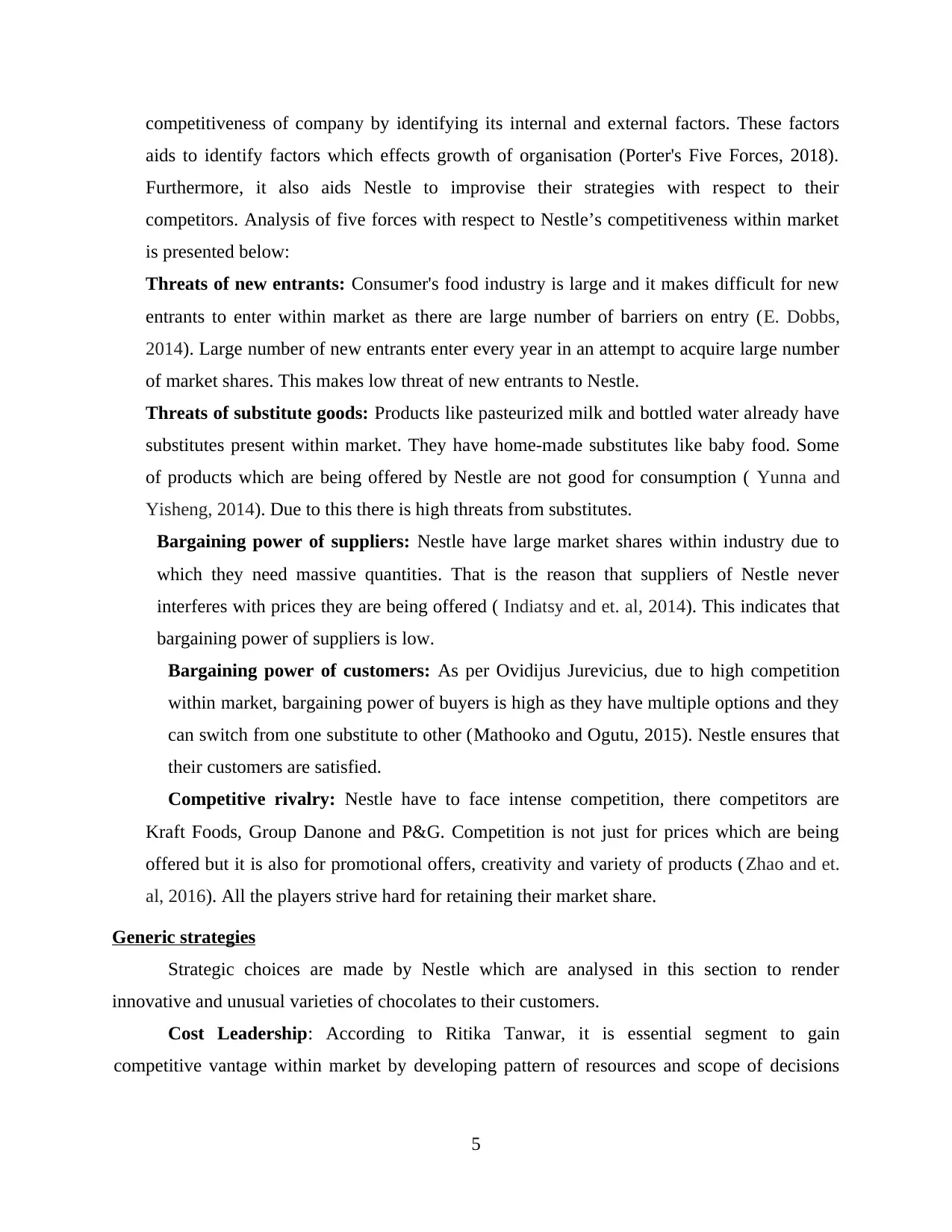
competitiveness of company by identifying its internal and external factors. These factors
aids to identify factors which effects growth of organisation (Porter's Five Forces, 2018).
Furthermore, it also aids Nestle to improvise their strategies with respect to their
competitors. Analysis of five forces with respect to Nestle’s competitiveness within market
is presented below:
Threats of new entrants: Consumer's food industry is large and it makes difficult for new
entrants to enter within market as there are large number of barriers on entry (E. Dobbs,
2014). Large number of new entrants enter every year in an attempt to acquire large number
of market shares. This makes low threat of new entrants to Nestle.
Threats of substitute goods: Products like pasteurized milk and bottled water already have
substitutes present within market. They have home-made substitutes like baby food. Some
of products which are being offered by Nestle are not good for consumption ( Yunna and
Yisheng, 2014). Due to this there is high threats from substitutes.
Bargaining power of suppliers: Nestle have large market shares within industry due to
which they need massive quantities. That is the reason that suppliers of Nestle never
interferes with prices they are being offered ( Indiatsy and et. al, 2014). This indicates that
bargaining power of suppliers is low.
Bargaining power of customers: As per Ovidijus Jurevicius, due to high competition
within market, bargaining power of buyers is high as they have multiple options and they
can switch from one substitute to other (Mathooko and Ogutu, 2015). Nestle ensures that
their customers are satisfied.
Competitive rivalry: Nestle have to face intense competition, there competitors are
Kraft Foods, Group Danone and P&G. Competition is not just for prices which are being
offered but it is also for promotional offers, creativity and variety of products (Zhao and et.
al, 2016). All the players strive hard for retaining their market share.
Generic strategies
Strategic choices are made by Nestle which are analysed in this section to render
innovative and unusual varieties of chocolates to their customers.
Cost Leadership: According to Ritika Tanwar, it is essential segment to gain
competitive vantage within market by developing pattern of resources and scope of decisions
5
aids to identify factors which effects growth of organisation (Porter's Five Forces, 2018).
Furthermore, it also aids Nestle to improvise their strategies with respect to their
competitors. Analysis of five forces with respect to Nestle’s competitiveness within market
is presented below:
Threats of new entrants: Consumer's food industry is large and it makes difficult for new
entrants to enter within market as there are large number of barriers on entry (E. Dobbs,
2014). Large number of new entrants enter every year in an attempt to acquire large number
of market shares. This makes low threat of new entrants to Nestle.
Threats of substitute goods: Products like pasteurized milk and bottled water already have
substitutes present within market. They have home-made substitutes like baby food. Some
of products which are being offered by Nestle are not good for consumption ( Yunna and
Yisheng, 2014). Due to this there is high threats from substitutes.
Bargaining power of suppliers: Nestle have large market shares within industry due to
which they need massive quantities. That is the reason that suppliers of Nestle never
interferes with prices they are being offered ( Indiatsy and et. al, 2014). This indicates that
bargaining power of suppliers is low.
Bargaining power of customers: As per Ovidijus Jurevicius, due to high competition
within market, bargaining power of buyers is high as they have multiple options and they
can switch from one substitute to other (Mathooko and Ogutu, 2015). Nestle ensures that
their customers are satisfied.
Competitive rivalry: Nestle have to face intense competition, there competitors are
Kraft Foods, Group Danone and P&G. Competition is not just for prices which are being
offered but it is also for promotional offers, creativity and variety of products (Zhao and et.
al, 2016). All the players strive hard for retaining their market share.
Generic strategies
Strategic choices are made by Nestle which are analysed in this section to render
innovative and unusual varieties of chocolates to their customers.
Cost Leadership: According to Ritika Tanwar, it is essential segment to gain
competitive vantage within market by developing pattern of resources and scope of decisions
5
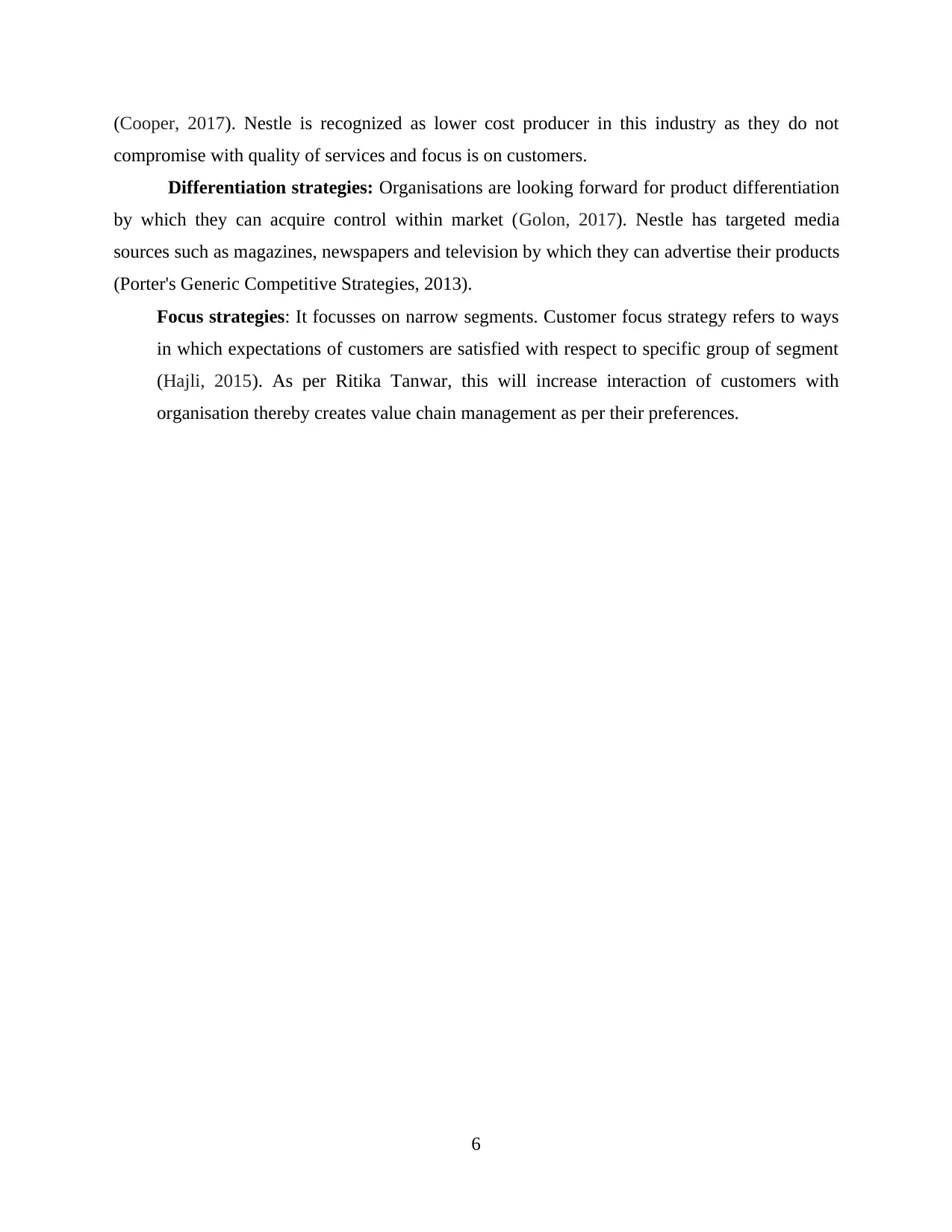
(Cooper, 2017). Nestle is recognized as lower cost producer in this industry as they do not
compromise with quality of services and focus is on customers.
Differentiation strategies: Organisations are looking forward for product differentiation
by which they can acquire control within market (Golon, 2017). Nestle has targeted media
sources such as magazines, newspapers and television by which they can advertise their products
(Porter's Generic Competitive Strategies, 2013).
Focus strategies: It focusses on narrow segments. Customer focus strategy refers to ways
in which expectations of customers are satisfied with respect to specific group of segment
(Hajli, 2015). As per Ritika Tanwar, this will increase interaction of customers with
organisation thereby creates value chain management as per their preferences.
6
compromise with quality of services and focus is on customers.
Differentiation strategies: Organisations are looking forward for product differentiation
by which they can acquire control within market (Golon, 2017). Nestle has targeted media
sources such as magazines, newspapers and television by which they can advertise their products
(Porter's Generic Competitive Strategies, 2013).
Focus strategies: It focusses on narrow segments. Customer focus strategy refers to ways
in which expectations of customers are satisfied with respect to specific group of segment
(Hajli, 2015). As per Ritika Tanwar, this will increase interaction of customers with
organisation thereby creates value chain management as per their preferences.
6
⊘ This is a preview!⊘
Do you want full access?
Subscribe today to unlock all pages.

Trusted by 1+ million students worldwide
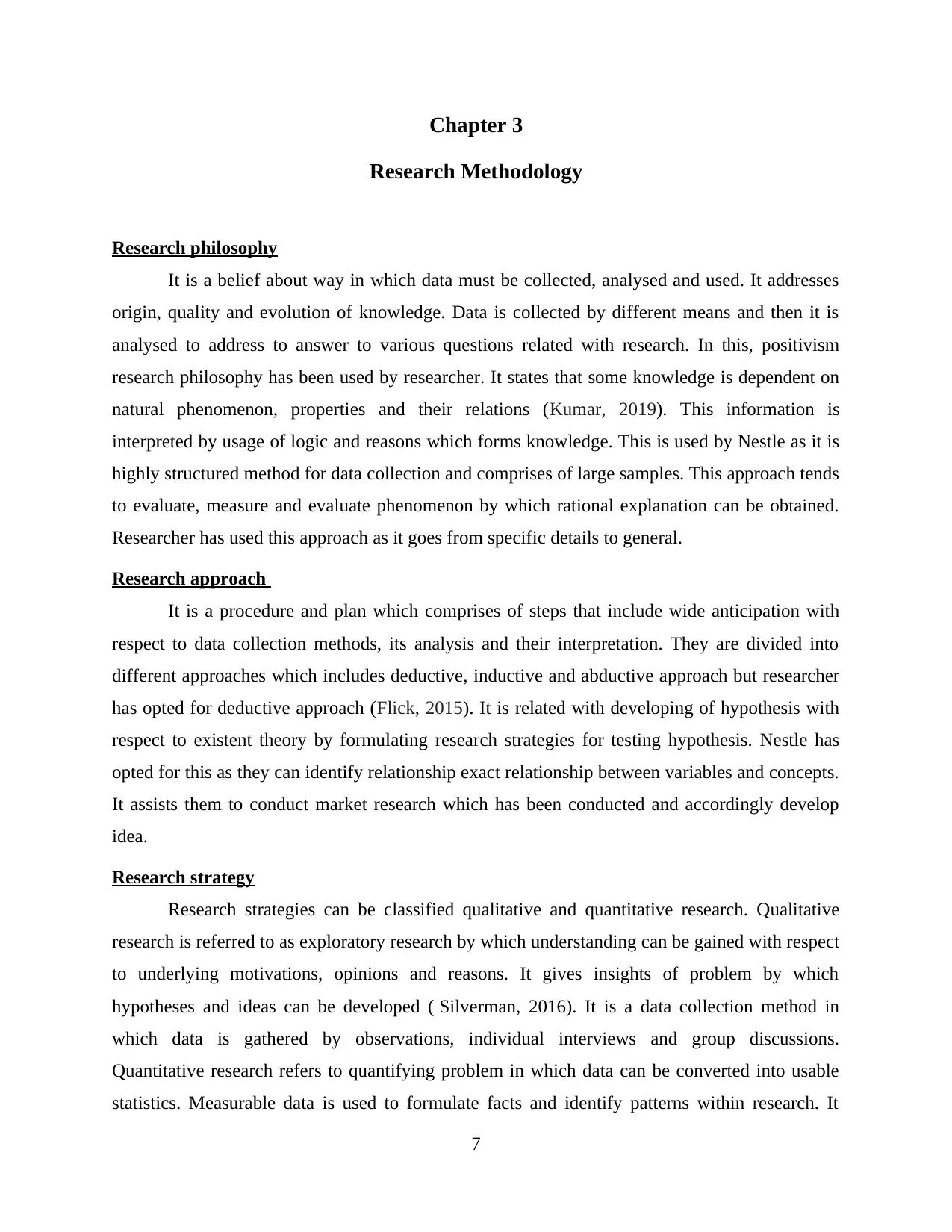
Chapter 3
Research Methodology
Research philosophy
It is a belief about way in which data must be collected, analysed and used. It addresses
origin, quality and evolution of knowledge. Data is collected by different means and then it is
analysed to address to answer to various questions related with research. In this, positivism
research philosophy has been used by researcher. It states that some knowledge is dependent on
natural phenomenon, properties and their relations (Kumar, 2019). This information is
interpreted by usage of logic and reasons which forms knowledge. This is used by Nestle as it is
highly structured method for data collection and comprises of large samples. This approach tends
to evaluate, measure and evaluate phenomenon by which rational explanation can be obtained.
Researcher has used this approach as it goes from specific details to general.
Research approach
It is a procedure and plan which comprises of steps that include wide anticipation with
respect to data collection methods, its analysis and their interpretation. They are divided into
different approaches which includes deductive, inductive and abductive approach but researcher
has opted for deductive approach (Flick, 2015). It is related with developing of hypothesis with
respect to existent theory by formulating research strategies for testing hypothesis. Nestle has
opted for this as they can identify relationship exact relationship between variables and concepts.
It assists them to conduct market research which has been conducted and accordingly develop
idea.
Research strategy
Research strategies can be classified qualitative and quantitative research. Qualitative
research is referred to as exploratory research by which understanding can be gained with respect
to underlying motivations, opinions and reasons. It gives insights of problem by which
hypotheses and ideas can be developed ( Silverman, 2016). It is a data collection method in
which data is gathered by observations, individual interviews and group discussions.
Quantitative research refers to quantifying problem in which data can be converted into usable
statistics. Measurable data is used to formulate facts and identify patterns within research. It
7
Research Methodology
Research philosophy
It is a belief about way in which data must be collected, analysed and used. It addresses
origin, quality and evolution of knowledge. Data is collected by different means and then it is
analysed to address to answer to various questions related with research. In this, positivism
research philosophy has been used by researcher. It states that some knowledge is dependent on
natural phenomenon, properties and their relations (Kumar, 2019). This information is
interpreted by usage of logic and reasons which forms knowledge. This is used by Nestle as it is
highly structured method for data collection and comprises of large samples. This approach tends
to evaluate, measure and evaluate phenomenon by which rational explanation can be obtained.
Researcher has used this approach as it goes from specific details to general.
Research approach
It is a procedure and plan which comprises of steps that include wide anticipation with
respect to data collection methods, its analysis and their interpretation. They are divided into
different approaches which includes deductive, inductive and abductive approach but researcher
has opted for deductive approach (Flick, 2015). It is related with developing of hypothesis with
respect to existent theory by formulating research strategies for testing hypothesis. Nestle has
opted for this as they can identify relationship exact relationship between variables and concepts.
It assists them to conduct market research which has been conducted and accordingly develop
idea.
Research strategy
Research strategies can be classified qualitative and quantitative research. Qualitative
research is referred to as exploratory research by which understanding can be gained with respect
to underlying motivations, opinions and reasons. It gives insights of problem by which
hypotheses and ideas can be developed ( Silverman, 2016). It is a data collection method in
which data is gathered by observations, individual interviews and group discussions.
Quantitative research refers to quantifying problem in which data can be converted into usable
statistics. Measurable data is used to formulate facts and identify patterns within research. It
7
Paraphrase This Document
Need a fresh take? Get an instant paraphrase of this document with our AI Paraphraser
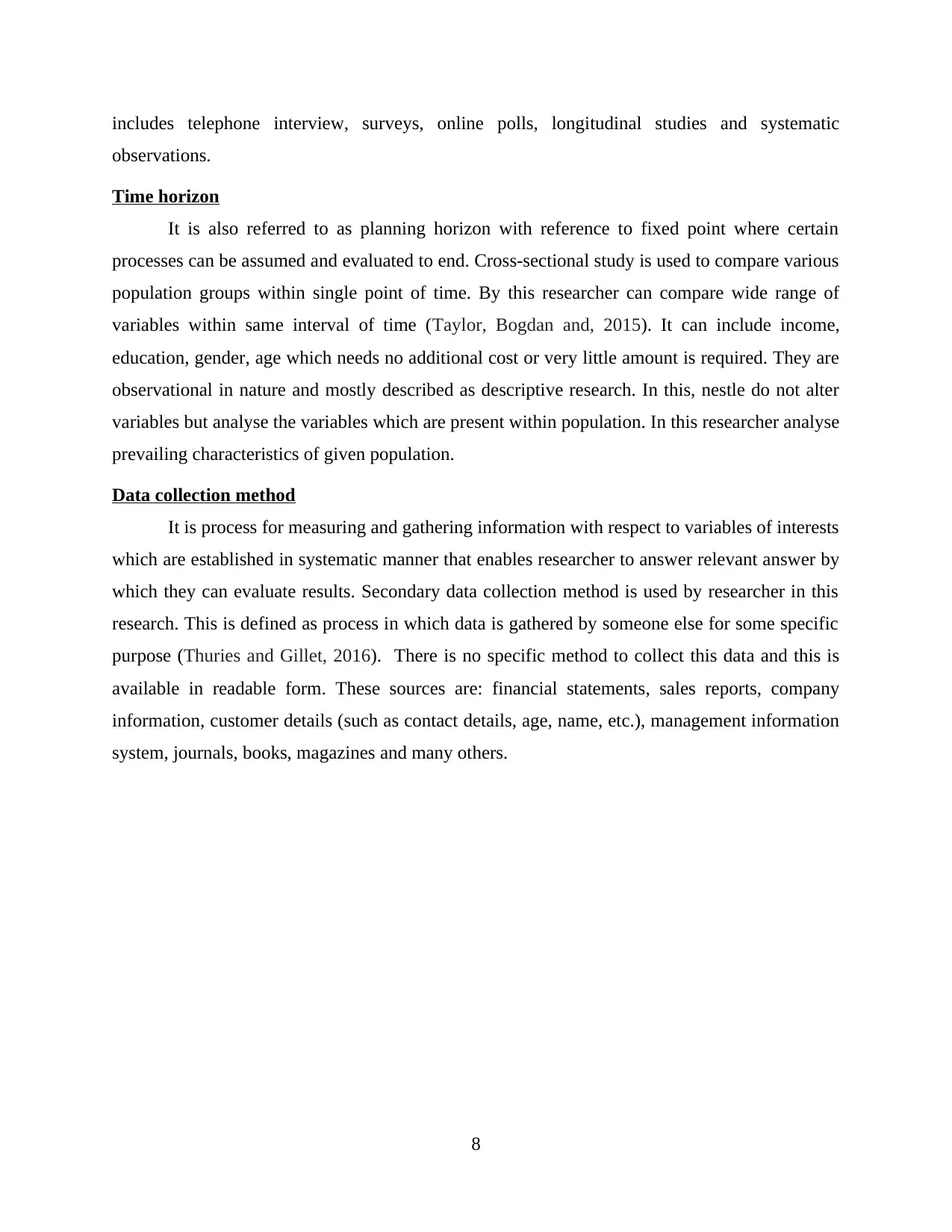
includes telephone interview, surveys, online polls, longitudinal studies and systematic
observations.
Time horizon
It is also referred to as planning horizon with reference to fixed point where certain
processes can be assumed and evaluated to end. Cross-sectional study is used to compare various
population groups within single point of time. By this researcher can compare wide range of
variables within same interval of time (Taylor, Bogdan and, 2015). It can include income,
education, gender, age which needs no additional cost or very little amount is required. They are
observational in nature and mostly described as descriptive research. In this, nestle do not alter
variables but analyse the variables which are present within population. In this researcher analyse
prevailing characteristics of given population.
Data collection method
It is process for measuring and gathering information with respect to variables of interests
which are established in systematic manner that enables researcher to answer relevant answer by
which they can evaluate results. Secondary data collection method is used by researcher in this
research. This is defined as process in which data is gathered by someone else for some specific
purpose (Thuries and Gillet, 2016). There is no specific method to collect this data and this is
available in readable form. These sources are: financial statements, sales reports, company
information, customer details (such as contact details, age, name, etc.), management information
system, journals, books, magazines and many others.
8
observations.
Time horizon
It is also referred to as planning horizon with reference to fixed point where certain
processes can be assumed and evaluated to end. Cross-sectional study is used to compare various
population groups within single point of time. By this researcher can compare wide range of
variables within same interval of time (Taylor, Bogdan and, 2015). It can include income,
education, gender, age which needs no additional cost or very little amount is required. They are
observational in nature and mostly described as descriptive research. In this, nestle do not alter
variables but analyse the variables which are present within population. In this researcher analyse
prevailing characteristics of given population.
Data collection method
It is process for measuring and gathering information with respect to variables of interests
which are established in systematic manner that enables researcher to answer relevant answer by
which they can evaluate results. Secondary data collection method is used by researcher in this
research. This is defined as process in which data is gathered by someone else for some specific
purpose (Thuries and Gillet, 2016). There is no specific method to collect this data and this is
available in readable form. These sources are: financial statements, sales reports, company
information, customer details (such as contact details, age, name, etc.), management information
system, journals, books, magazines and many others.
8
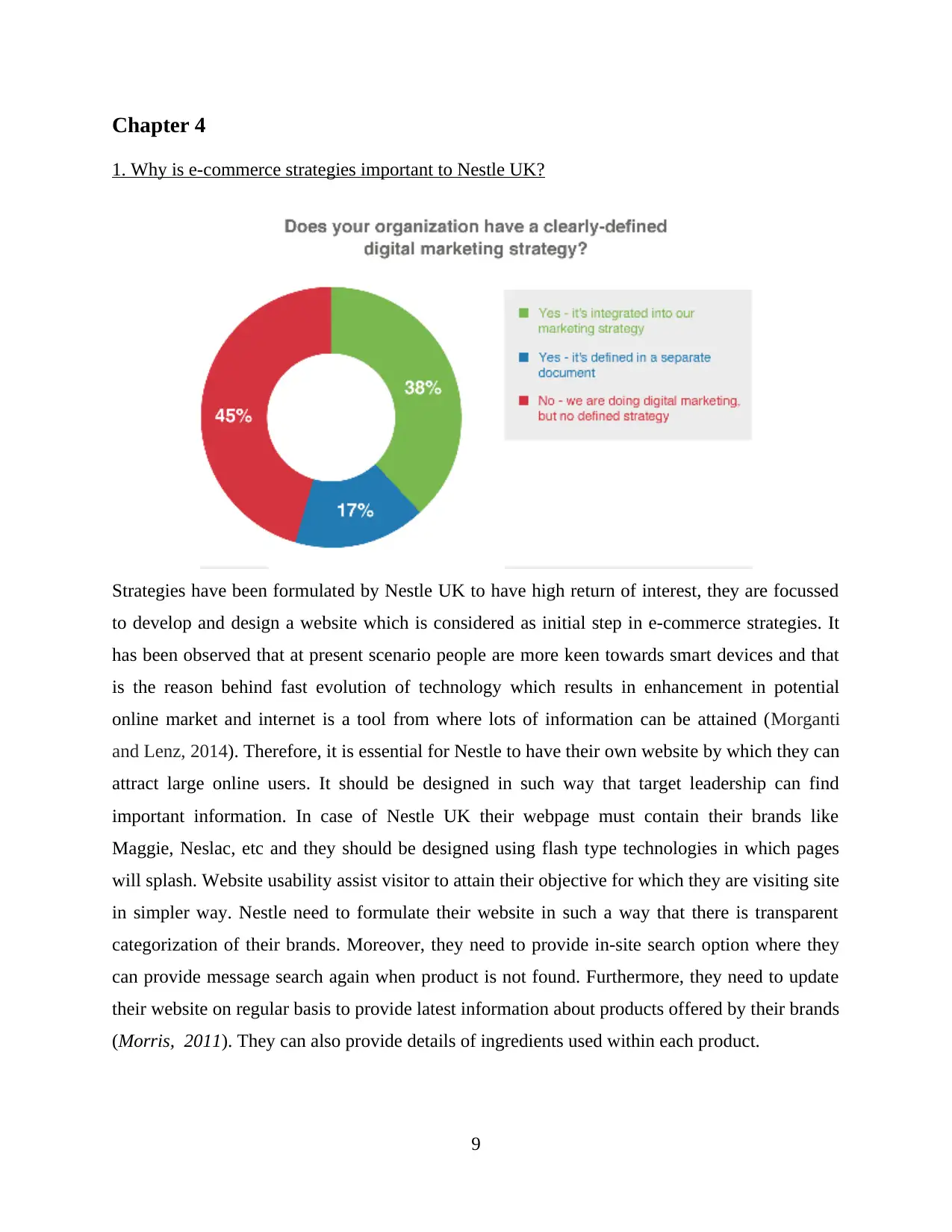
Chapter 4
1. Why is e-commerce strategies important to Nestle UK?
Strategies have been formulated by Nestle UK to have high return of interest, they are focussed
to develop and design a website which is considered as initial step in e-commerce strategies. It
has been observed that at present scenario people are more keen towards smart devices and that
is the reason behind fast evolution of technology which results in enhancement in potential
online market and internet is a tool from where lots of information can be attained (Morganti
and Lenz, 2014). Therefore, it is essential for Nestle to have their own website by which they can
attract large online users. It should be designed in such way that target leadership can find
important information. In case of Nestle UK their webpage must contain their brands like
Maggie, Neslac, etc and they should be designed using flash type technologies in which pages
will splash. Website usability assist visitor to attain their objective for which they are visiting site
in simpler way. Nestle need to formulate their website in such a way that there is transparent
categorization of their brands. Moreover, they need to provide in-site search option where they
can provide message search again when product is not found. Furthermore, they need to update
their website on regular basis to provide latest information about products offered by their brands
(Morris, 2011). They can also provide details of ingredients used within each product.
9
1. Why is e-commerce strategies important to Nestle UK?
Strategies have been formulated by Nestle UK to have high return of interest, they are focussed
to develop and design a website which is considered as initial step in e-commerce strategies. It
has been observed that at present scenario people are more keen towards smart devices and that
is the reason behind fast evolution of technology which results in enhancement in potential
online market and internet is a tool from where lots of information can be attained (Morganti
and Lenz, 2014). Therefore, it is essential for Nestle to have their own website by which they can
attract large online users. It should be designed in such way that target leadership can find
important information. In case of Nestle UK their webpage must contain their brands like
Maggie, Neslac, etc and they should be designed using flash type technologies in which pages
will splash. Website usability assist visitor to attain their objective for which they are visiting site
in simpler way. Nestle need to formulate their website in such a way that there is transparent
categorization of their brands. Moreover, they need to provide in-site search option where they
can provide message search again when product is not found. Furthermore, they need to update
their website on regular basis to provide latest information about products offered by their brands
(Morris, 2011). They can also provide details of ingredients used within each product.
9
⊘ This is a preview!⊘
Do you want full access?
Subscribe today to unlock all pages.

Trusted by 1+ million students worldwide
1 out of 20
Related Documents
Your All-in-One AI-Powered Toolkit for Academic Success.
+13062052269
info@desklib.com
Available 24*7 on WhatsApp / Email
![[object Object]](/_next/static/media/star-bottom.7253800d.svg)
Unlock your academic potential
Copyright © 2020–2025 A2Z Services. All Rights Reserved. Developed and managed by ZUCOL.





